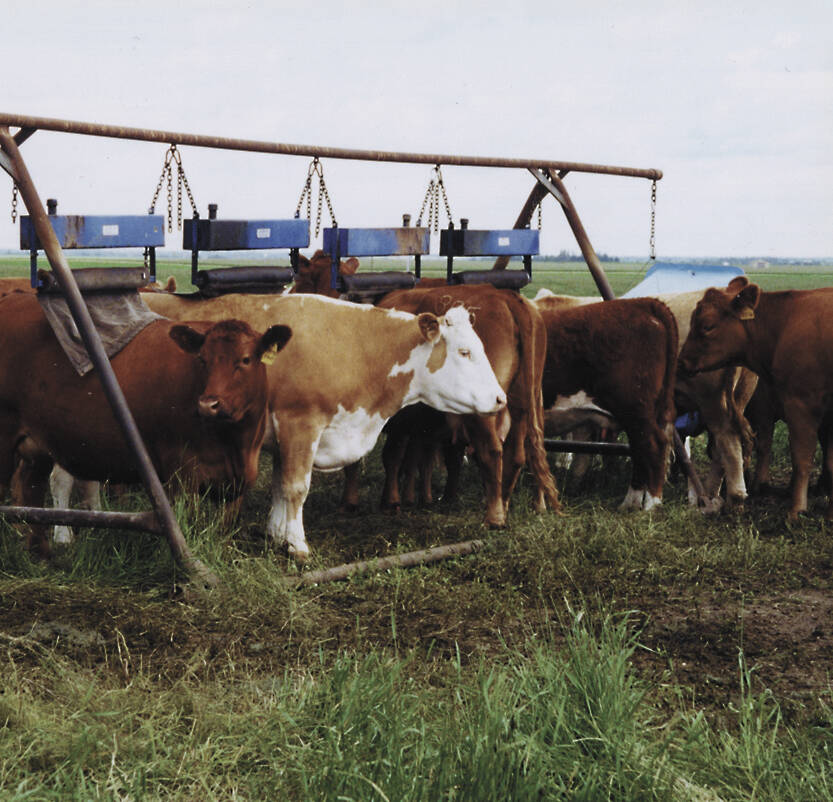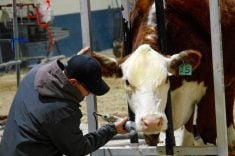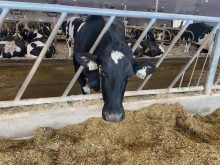The return on investment can be short for sheep producers who buy a mixer for total mixed rations (TMR), according to participants in a daily demonstration at the sheep handling area during Canada’s Outdoor Farm Show in Ontario in September.
Why it matters: Switching to TMR feeding is a major investment and a major change in mindset for many sheep farmers, but can pay financial and flock health dividends.
Michael Richards raises a crossbred Dorset/Rideau flock of ewes and market lambs in southern Ontario. When he began raising the flock, he fed dry hay in the morning, top-dressed with grain later in the day and then cleaned out what was left in the feed bunk and fed it to beef cattle.
Read Also

Shifting standards on cattle parasite control
Parasite product resistance has more farmers and veterinarians thinking differently about how to control issues like lice or worms.
Seeking cost savings and less feed waste, he bought a Jaylor “mini” TMR mixer. The results were even better than expected. Richards told demo attendees that his feed costs went from $1.50 per head per day to 43 cents per head per day. Labour savings were also significant.
This was no surprise to ruminant nutritionist Courtney Vriens, operator of Ontario-based Vriens Nutrition Consulting, where she works with dairy and meat sheep producers across Canada to fine-tune rations.
“Sheep can consume all these feed components in a very efficient manner,” she said, but not if they’re given the opportunity to sort.
If grain is top-dressed for sheep in higher production stages, acidosis risk can increase, but this is mitigated when that same amount of grain is included in a TMR.
Vriens said TMRs can allow sheep producers to switch from expensive pelleted feeds and instead use more home-grown or alternative feeds such as corn distiller’s grains.
For the demonstration, Jaylor supplied a self-propelled, 91-cubic-foot mixer powered by a Honda engine and three hydraulic wheel motors.
“This mixer is quite capable of moving around inside or outside the barn,” said Ontario/Manitoba territory manager Jerry Oude Egberink.
Other options in the company’s mini TMR mixer line include stationary, truck-mounted, trailer or skid steer-mounted units.
A mix of straw, haylage and grain corn was created for the demo. Richards said he uses corn silage in his TMR for much of the year but while he waits for corn harvest, he is using oatlage, dry balage and concentrate.
With high-quality haylage and corn silage, added straw or coarse grassy hay makes sheep feel full without consuming too much, said Vriens. This is good for dry ewes that don’t need many high-quality ingredients.
For those in higher production phases on either milk or meat farms, less or no straw or coarse hay is appropriate.
Switching to TMR allows producers to get away from slug feeding concentrate, which is typically done by top-dressing grain. If the forage is consumed at the same time as the concentrate, “that’s a very healthy way to feed ruminants,” Vriens said.
TMR also allows introduction of ground grains or corn distillers byproducts.
“We can really save costs significantly compared to purchasing all those manufactured pellets.”
Vriens highlighted ingredient accuracy and chopping long-stemmed forages as the main benefits of TMR feeding in sheep.
“We can be a lot more accurate with the rations that I’m balancing for the farms,” she said. “Instead of relying on free choice mineral consumption, we’re putting it right into the mix to target a desired intake.”
Chopping long-stemmed forages makes them easier for sheep to consume while counteracting their well-known tendency to sort and waste feed.
“For our very prolific sheep that are carrying a lot of lambs in late pregnancy, by having those forage particles smaller, we can increase dry matter intake to better meet requirements without causing acidosis or digestive upset,” Vriens said.
“The same is true for high-producing dairy ewes. And in terms of feed waste, (chopping) is also a huge benefit (because) we’re not having those very long forage particles that they’re sorting out. Ten per cent or even 30 per cent waste is what some people tell me they were seeing, and now they see an improvement of up to 30 per cent more feed on their farm when they go to TMR.”
Egberink said one Ontario producer is feeding 800 head with a single Jaylor mini-TMR mixer.
“Whatever number you want to feed, that machine’s a good fit,” he said.
With models ranging in cost from $13,000 to $36,000, “there seems to be a fit for it everywhere.”
“Sheep barns are generally tighter to get around because (the producers) are utilizing every little bit of space in the barns, and you don’t have room to get big equipment through,” he said. “A small TMR can basically turn on a dime. It’s better to have something that can maneuver nicely and get around.”
Richards likes the performance of his Jaylor mini-mixer outside the barn.
“That thing goes through snow better than a snowmobile,” he told the demo audience. “I have yet to get it stuck.”















